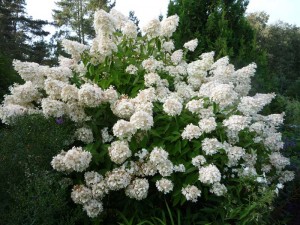Hydrangea tree anabel care. How to prepare a shrub for the onset of winter? Planting and caring for hydrangea
Have beautiful flower beds with seductively beautiful flowers is not difficult if the plants themselves do not require complex care, likehydrangea arborescens annabelle. Its decorativeness allows it to be a decoration of the garden, and the undemanding nature of the shrub is to the liking of every designer, because planting and conditions for survival and good growth quite simple
What's special about this hydrangea?
Annabelle hydrangea inflorescences are special. And not only because of the shape of the ball, but also because large size. 25 cm in diameter - these are the largest decorations on this flower. By the way, the flowering lasts long enough so that everyone can admire it. While it's warm, you should take time for beauty and watch Annabelle. Moreover, a bush can surprise with its personal"tricks".
The peculiarity of the plant is that its buds may have a different color, but not due to changes in soil acidity, but because they react to colored water.
Prankster flower growers will be able to have a great “friend”, with which you can experiment and even achieve several contrasting colors of buds on one bush.One and a half meters - maximum growth for shrubs. True, it must be said that the peculiarity is that its growth rate is very high. In a year it can grow by 20 cm. The plant can be anything in width - growing even 3 meters is not a problem for it. The erect and spreading stem will be decorated with oval leaves, the size of a palm. Their uneven edges are also a feature of the long-lived shrub. Middle age Annabelle is 50 years old. The flower does not like transplants.
How to care for a beautiful bush
For the unpretentious Annabelle
planting and care - it's a simple matter. Its high ability to take root and grow in almost all places makes the shrub universal. It tolerates winters easily, except in the northern regions. There, even mature bushes should be protected with shelter during the coldest period of the year. True, it still exists small details, which should be taken into account. The most appropriate time for planting is late spring or early autumn.The location should be selected according to the following criteria:
- be well lit, but not in direct sunlight (Annabelle can"survive" and in the shade, but its growth rate will decrease significantly, as will the brightness and splendor of flowering);
- do not be in drafts;
- the soil should be with increased acidity and drain well (the plant does not tolerate stagnant water).
Annabelle likes regular watering. At the same time, the development of the bush and flowering activity will always be at the highest level. Therefore, during dry periods, you should not forget about watering. The plant does not accept either excessive drying out or too much water, just as it respects"weeds". Loosening the soil around this type of hydrangea is one of the types of pleasant attention that it will certainly appreciate.
Planting and care include such important points as feeding and correct pruning. This plant loves organic fertilizers and mineral composition. The best stages to carry out these manipulations there will be autumn-spring period. In principle, it does not tolerate lime and ash. While there are buds on Annabelle, you should not fertilize it, otherwise the flowers on it will turn green. Like others tree plants, it needs pruning to form a rounded crown.
During the autumn period you should:
- remove dry branches;
- collect dried inflorescences;
- shorten young shoots by 1/3 to 10 pieces from the entire bush, and cut off the rest completely.
All of the above applies to shrubs whose age has already exceeded 3 years.
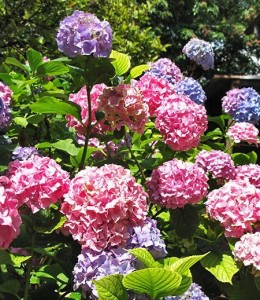 Annabelle
Annabelle
The root collar of the shrub should not be covered with soil; it is better to be level with the ground. Mulching the root circle is an important point. It is carried out using peat and sawdust. At first, the inflorescences of a young bush should be cut off. The purpose of the manipulation is to strengthen the bush. Strength must first go into growth and only then into flowering.
Reproduction
Description caring for a plant is impossible without focusing the attention of amateur gardeners on the characteristics of reproduction.
Annabelle can be bred in three types:
- division;
- cuttings;
- using layering.
Branches that reach a length of 10 cm after pruning are suitable for use as cuttings. As usual, before planting they should"insist" in a solution with growth stimulants. The best for rooting will be a peat mixture, to which humus and soil are added. The rooting procedure should be carried out in the shade under cover. You can use plastic bottles. Cuttings should be ventilated periodically.
Planting in the ground for the winter is prohibited. The cuttings will simply freeze.
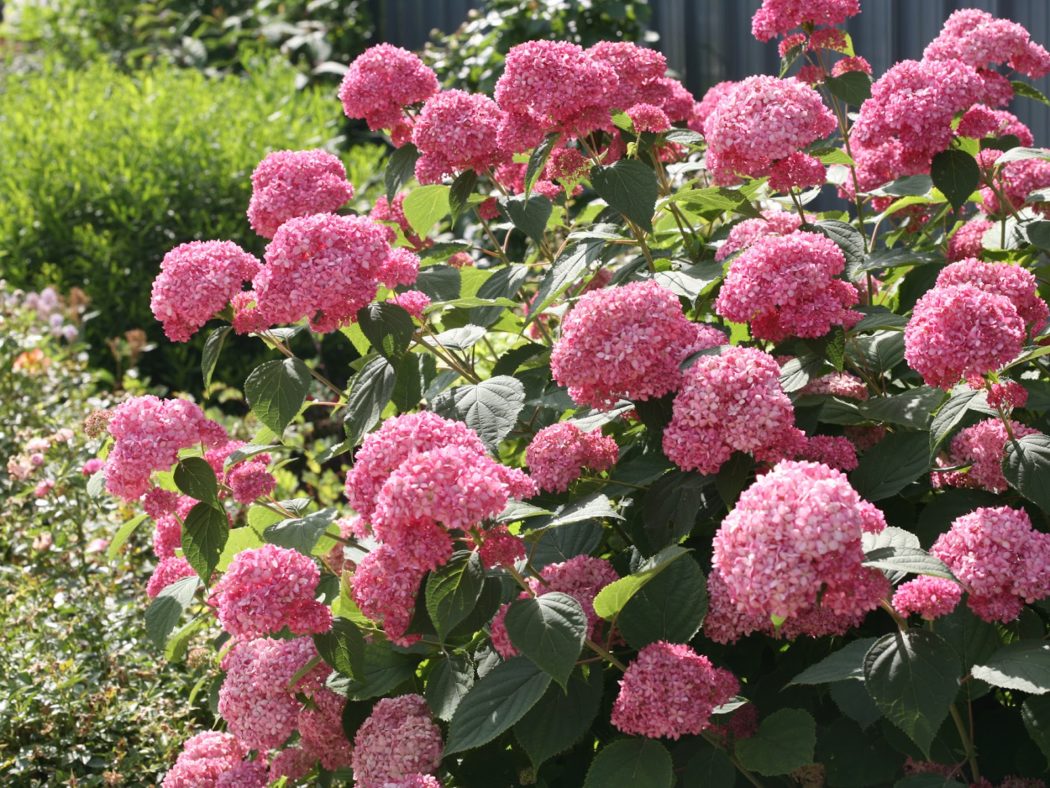 When dividing the bush, monitor for possible root disturbances. The divisions must have their own developed root systems. Watering parts for planting is an indispensable manipulation that helps create best conditions for future Annabelle bushes.
When dividing the bush, monitor for possible root disturbances. The divisions must have their own developed root systems. Watering parts for planting is an indispensable manipulation that helps create best conditions for future Annabelle bushes.
Propagation by layering is one of the most favorite methods among gardeners. Cut annual shoots should be pressed to the ground. You can use wire for this. Cover this area with mulch. Here next year there will already be a full-fledged seedling from which a beautiful bush will grow.
Annabelle hydrangea diseases
To prevent pests that threatenHydrangea tree Annabelle, it should be watered with a manganese solution directly under the roots. Plants also suffer from powdery mildew and chlorosis. In such situations, insecticides help. From spider mite attacks, which manifest themselves externally in the yellowness of the leaves and the presence of cobwebs on the plant, they are saved by treating chemicals. To prevent the situation with the occurrence of spider mites from happening again, you should monitor the level of soil moisture. If it dries out, a repeated attack by insects is possible.
Conditions for propagation, breeding and caring for Annabelle hydrangea are not difficult. However, you should definitely adhere to them so that the bush will delight you with its beautiful flowering all summer.
Every gardener, even a beginner, is proud of his flower beds, where well-groomed flowers grow. A lot will depend on the right choice of plants. It is important that your pets combine not only decorative properties, but also ease of care. Hydrangea tree Annabelle - will the right choice. It will perfectly decorate any garden. The shrub combines well with other flowers, which is why people like to use it landscape designers. Also, planting and caring for a flower is not difficult.
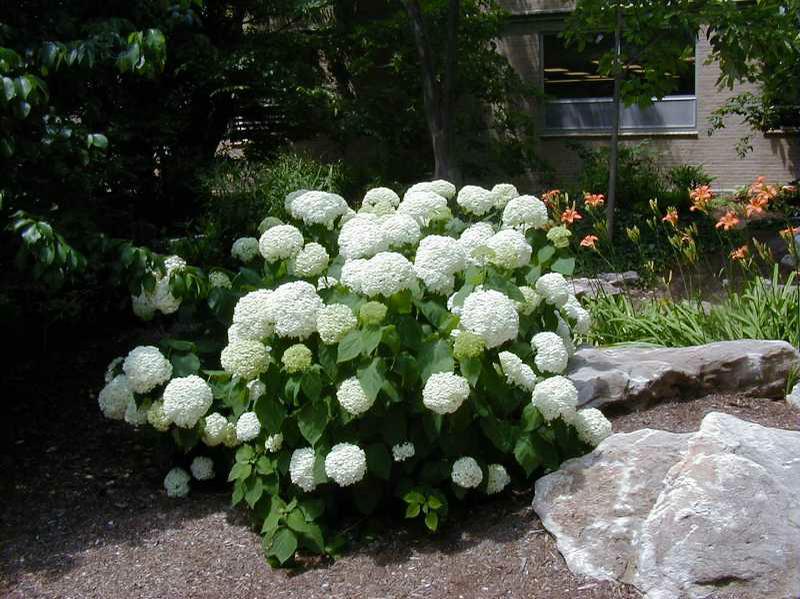
Description of the plant
Hydrangea Annabelle is interesting for its inflorescences, which are shaped like a ball and can form up to 25 centimeters in diameter. They show off on a compact bush long time. By growing this plant, you can confidently observe flowering throughout the warm period.
This variety of hydrangea has its own uniqueness. It consists of artificially changing the shade of colors. The fact is that if you water the bush with water colored in any color, then your buds will turn exactly that color. With some ingenuity, you can even achieve several shades on the inflorescences of the bush.
The plant does not grow higher than one and a half meters in height, but in width it can stretch up to three meters. The stem is erect, spreading. The shoots bear palm-sized leaves. They are oval, the edges are uneven.
The shrub is long-lived. Before planting it, decide on a permanent place of growth; the hydrangea will grow there for more than 50 years. But she doesn’t like the transplant. In general, the plant has an increased growth rate, since the shrub grows up to 20 centimeters per year.
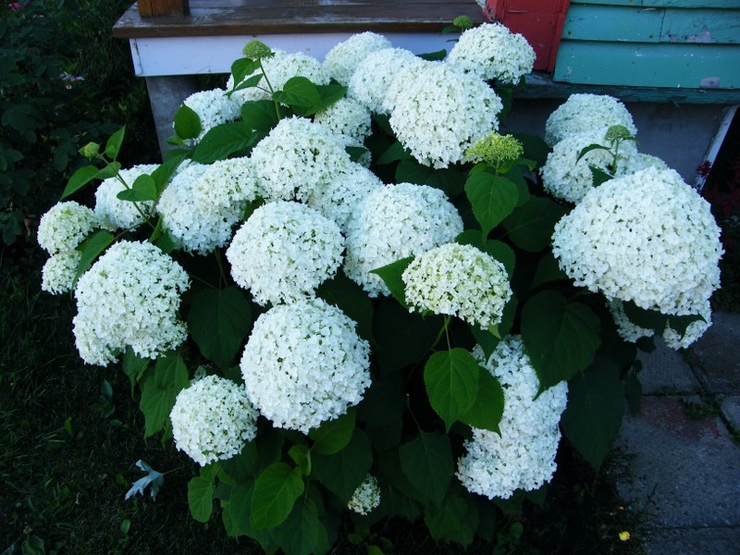
Planting and caring for shrubs
Annabelle hydrangea is not difficult to grow. It is unpretentious, can easily take root, growing quickly, on different places. In addition, it is resistant to diseases.
The best time to plant is either the end of spring or the beginning of autumn. When planting hydrangea, you need to take the choice of growing location very seriously. So, it should not be exposed to drafts and be under direct sun rays, but at the same time well lit. In the shade, of course, the shrub will also grow, but its growth will be slowed down, and the flowering will not be so bright and lush.
The soil for growth is selected well-drained and with an acidic environment. The hole for planting is not dug too deep, but quite wide, since the roots of the hydrangea are mostly located in width. When planting several bushes at once, you must ensure an interval between them of at least one and a half meters. Before planting, the hole is well moistened and fertilized with humus; you can add sand and leaf soil.
After you have planted the shrub, pay attention to root collar. It should not be covered, but at ground level. The root circle is mulched with peat or sawdust. At first, young inflorescences are cut off. This is done so that the bush is well strengthened and does not waste its energy on flowering. It will also be useful for hydrangeas to be watered with a manganese solution from time to time, this will help avoid attacks on the bush by pests. It is carried out directly under the root.
Hydrangea arborescens Annabelle requires, albeit not careful, but regular care. An important point There will be regular watering. He provides positive influence for the full development and active flowering of hydrangea. The shrub loves moisture, especially during dry periods. The soil should not be allowed to dry out too much. After moistening, you will need to loosen it, while getting rid of weeds.
The shrub responds well to root feeding with both mineral and organic fertilizers. They are held in spring and autumn periods. It is not recommended to feed hydrangea during budding. This will cause the inflorescences to begin to turn green. It is important to remember that adding lime and ash under the bush is strictly prohibited.
Tree hydrangea tolerates winter well; it is not covered in adulthood, except northern regions. In these places it is better to cover the bush for the winter.
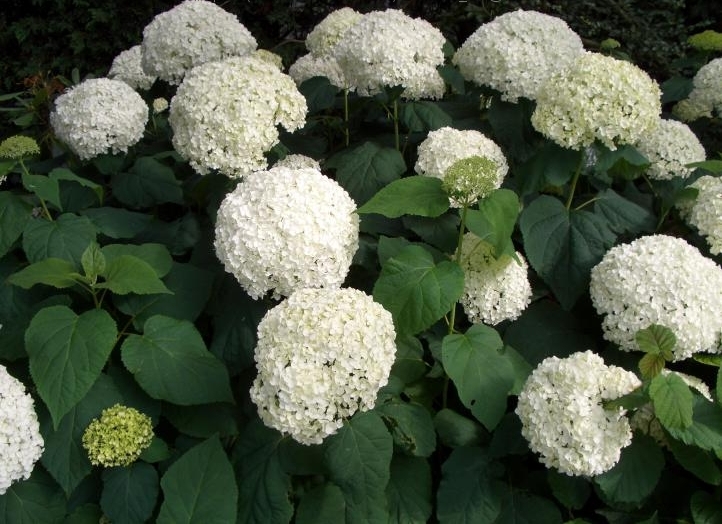
Pruning Annabelle tree hydrangea
Pruning is carried out in order to form a rounded crown. The procedure is carried out in the fall. During it, dry branches and inflorescences that have bloomed are removed. At the beginning of spring, the bush is rejuvenated. Young shoots in the amount of up to 10 pieces are shortened by a third. Everyone else is removed. It is important to remember one thing here, young shrubs three years don't cut.
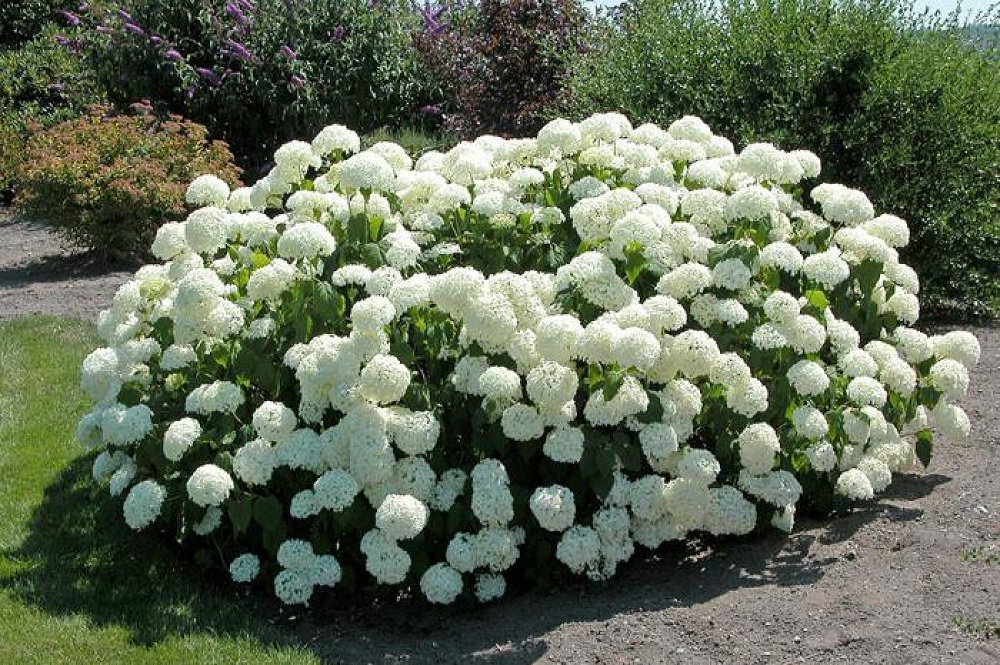
Shrub propagation
Tree hydrangea Anabel propagates by dividing the bush, cuttings and layering.
Cuttings are used after pruning at least 10 centimeters. They are treated with growth stimulants and rooted in a nutrient mixture of peat, sand, humus and soil. They are covered with a plastic bottle on top. Leave in the shade until rooting. Periodically remove the bottle and ventilate the cutting. At first, such rooted cuttings are not planted in the ground for the winter; they will freeze. They are kept in the basement, occasionally moistening the pots.
When dividing a bush mature plant divided into parts, trying not to damage the root system. Make sure that each division has its own well-defined root system. After planting, the parts are thoroughly watered.
Starting in autumn, hydrangea can be propagated by layering. Annual shoots are cut and pressed to the ground using wire. The top area is mulched. Next year, the shoot will form a full-fledged seedling. 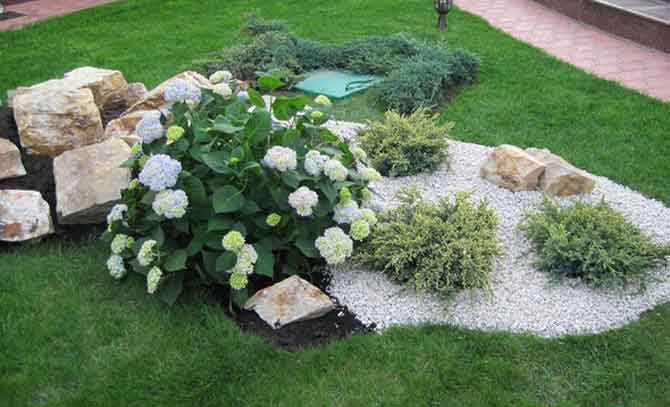
Diseases
Hydrangea can be susceptible to diseases such as powdery mildew and chlorosis. They are combated by treatment with special insecticides.
When poorly cared for, shrubs are most often attacked spider mite. Its presence will be indicated by the yellowness of the leaves and cobwebs on the bush. The reason for its attack will be insufficient moisture in the plant. By eliminating the cause and treating the bush, you will achieve its complete disappearance.
If the rose is called the queen of the garden, then the hydrangea can rightfully claim the title of princess. Hydrangeas are very popular among gardeners. About 35 species are grown. Most often, hydrangea is abundantly flowering shrub, but there are also small trees. And even vines.
In our latitudes, out of 35 species, only 5 types of hydrangeas are planted and grown: tree-like, paniculate, petiolate, ground cover and large-leaved. All of them are good in their own way, but gardeners consider large-leaved hydrangea to be the most decorative.
Planting hydrangeas
The best time to plant hydrangeas is early spring, when the soil has already thawed and the buds are just about to bloom. It must be remembered that hydrangeas are demanding on the soil. They love fertile, light, acidic soils and do not feel well in sandy soils and do not tolerate limestone at all. The depth of the planting hole is 40-50 cm, the diameter is at least 40 cm. Drainage is placed at the bottom of the planting hole - a layer of gravel or broken bricks, then half a bucket of peat mixed with 2 tablespoons of complex mineral fertilizer is poured. For planting, experts recommend using a soil mixture of 2 parts humus, 2 parts fertile soil, 1 part peat and 1 part sand. Before planting, broken and damaged shoots and roots are cut off with pruning shears.
The roots of the hydrangea seedling are straightened in different directions in the planting hole and sprinkled with prepared soil mixture on top. The root collar should be level with the soil level on the site. It is allowed to deepen the root collar no more than 2 cm, otherwise the plant will develop poorly. The soil mixture in the planting hole is carefully compacted and watered with 2 buckets of water so that the entire mixture is saturated with moisture. The final stage is mulching the tree trunk circle to avoid drying out the soil.
Caring for large-leaved hydrangea
If planting hydrangeas is the same for all five species, then caring for them is slightly different. More precisely, the care for large-leaved hydrangea is different, which needs to be cultivated differently than paniculate, petiolate, and tree-like. In the photo below there is a large-leaved hydrangea.
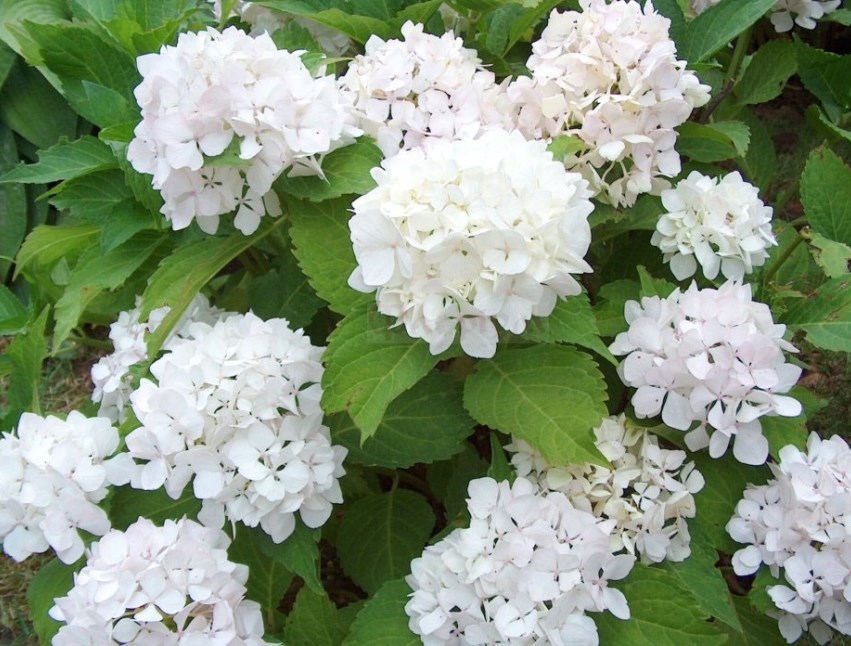 The thing is that large-leaved hydrangea, unlike other species grown in our gardens, blooms on last year’s shoots. That is, in large-leaved hydrangea flower buds are laid in the fall at the ends of the shoots. In the spring, these buds wake up and eventually produce huge caps of flowers. If last year's shoots freeze in the winter or the gardener, due to inexperience, prunes the bush in the spring, then the large-leaved hydrangea will not please him with flowering. Moreover, damage to last year's shoots can even lead to the death of the entire bush. Remember: large-leaved hydrangea is never pruned!
The thing is that large-leaved hydrangea, unlike other species grown in our gardens, blooms on last year’s shoots. That is, in large-leaved hydrangea flower buds are laid in the fall at the ends of the shoots. In the spring, these buds wake up and eventually produce huge caps of flowers. If last year's shoots freeze in the winter or the gardener, due to inexperience, prunes the bush in the spring, then the large-leaved hydrangea will not please him with flowering. Moreover, damage to last year's shoots can even lead to the death of the entire bush. Remember: large-leaved hydrangea is never pruned!
In spring trunk circle Large-leaved hydrangea is treated with complex mineral fertilizer. Even better if it is a special fertilizer for hydrangeas, rich in magnesium and iron, which acidify the soil around the bush. And hydrangea, as we remember, loves soils with sourness. In summer, hydrangea is fed mineral fertilizers with phosphorus and potassium, excluding nitrogen. In addition, when feeding, you need to take into account whether the hydrangea flowers are pink or blue. For blue hydrangeas (see photo) Aluminum sulfate is added to the fertilizer or the bushes are watered with a solution of iron salts.
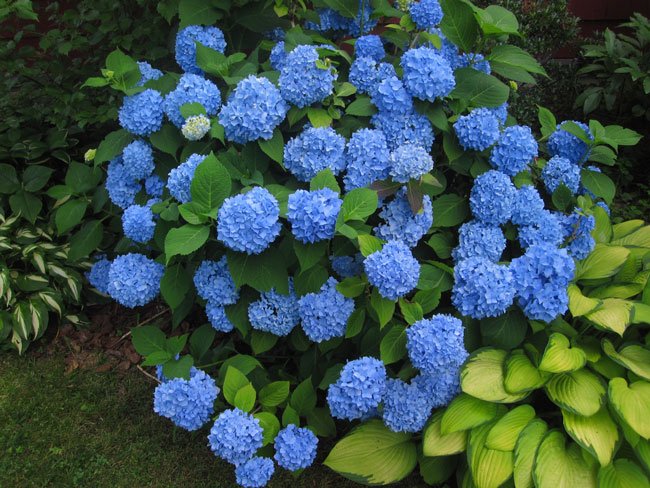 To get pink and raspberry color on acidic soils you can add chalk to the tree trunk several times a season or dolomite flour to increase soil pH to 6.0-6.2. And don’t forget to water the beauty regularly and generously!
To get pink and raspberry color on acidic soils you can add chalk to the tree trunk several times a season or dolomite flour to increase soil pH to 6.0-6.2. And don’t forget to water the beauty regularly and generously!
At the end of October, large-leaved hydrangea is covered to preserve flower buds. The shoots are carefully bent and pinned to the ground, and a bucket of peat is poured into the center of the bush. Next, all this is covered with dense covering material and covered with fallen leaves. Such a “fur coat” will not allow delicate flower buds to freeze out.
Hydrangea climbing (petiolate)
Petiolate hydrangea is the only vine in our gardens; other species are very heat-loving, so they do not take root here.
 After planting, small seedlings need to be sprayed with water 3-4 times a week. For an adult plant in the spring, in May, the first fertilizing is applied to the tree trunk circle. Hydrangea is fertilized with slurry in a ratio of 1:10 and complex mineral fertilizer. Subsequently, during the growing season, petiole hydrangea is fed another 3-4 times with complex mineral fertilizer. Watering should be plentiful, especially during drought - at least 2 buckets of water per plant once a week. For the winter, petiolate hydrangea is bent to the ground, the shoots are pinned and covered with fallen leaves.
After planting, small seedlings need to be sprayed with water 3-4 times a week. For an adult plant in the spring, in May, the first fertilizing is applied to the tree trunk circle. Hydrangea is fertilized with slurry in a ratio of 1:10 and complex mineral fertilizer. Subsequently, during the growing season, petiole hydrangea is fed another 3-4 times with complex mineral fertilizer. Watering should be plentiful, especially during drought - at least 2 buckets of water per plant once a week. For the winter, petiolate hydrangea is bent to the ground, the shoots are pinned and covered with fallen leaves.
Hydrangea Anabelle, which blooms with huge white caps of flowers, belongs to the tree hydrangeas and is one of the most popular varieties.
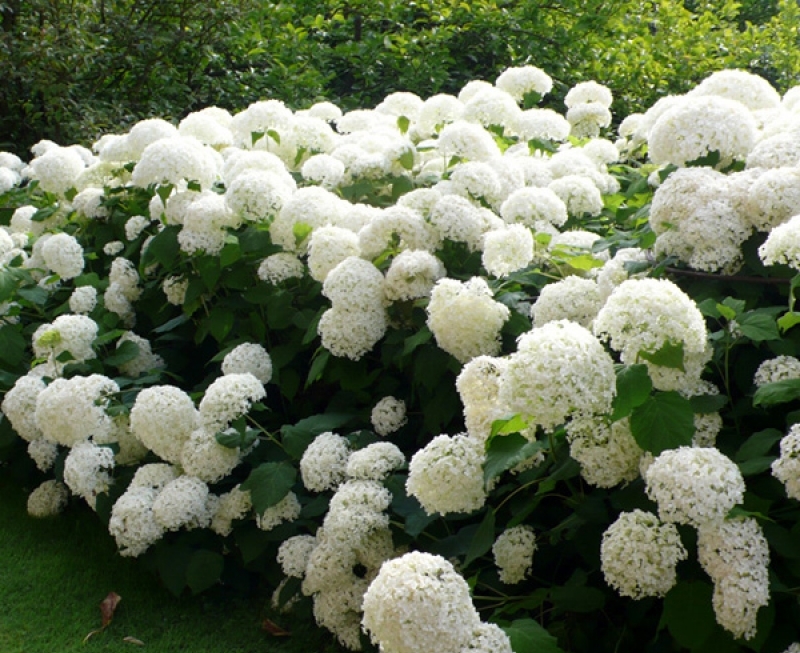 After planting, the small Anabel hydrangea needs to be protected from the hot sun and strong winds. In the first two years, you need to remove the inflorescences without regret so that the plant gets stronger and grows shoots. In May - feeding with slurry and complex fertilizers- just like petiole hydrangea. In summer - abundant watering. Fertilize 3-4 times a season with mineral fertilizers, but without fanaticism, because Anabel’s inflorescences may turn green. In autumn, the inflorescences are cut off. In early spring, the bush is pruned to obtain larger inflorescences, leaving 2-3 buds on the shoot. Weak and damaged shoots are also removed.
After planting, the small Anabel hydrangea needs to be protected from the hot sun and strong winds. In the first two years, you need to remove the inflorescences without regret so that the plant gets stronger and grows shoots. In May - feeding with slurry and complex fertilizers- just like petiole hydrangea. In summer - abundant watering. Fertilize 3-4 times a season with mineral fertilizers, but without fanaticism, because Anabel’s inflorescences may turn green. In autumn, the inflorescences are cut off. In early spring, the bush is pruned to obtain larger inflorescences, leaving 2-3 buds on the shoot. Weak and damaged shoots are also removed.
Paniculata hydrangea is as unpretentious to grow as tree hydrangea. In early spring, it needs pruning, which is carried out before the buds open. For abundant flowering Heavy pruning is recommended. Next is the already familiar cycle - in May, fertilizing with organic matter and complex mineral fertilizer, then three or four fertilizing with mineral fertilizers during the growing season and abundant watering. To strengthen the shoots of paniculata hydrangea, it is also recommended to water the bush once a month with a solution of potassium permanganate - 0.5 g per bucket. You can grow the same gorgeous hydrangea paniculata bush as in the photo:
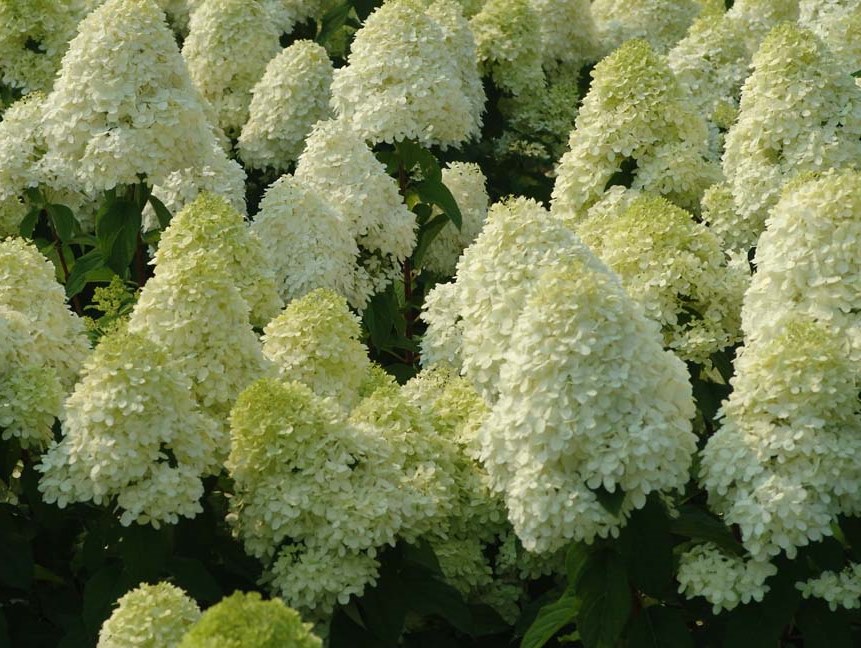
Since 2008, the family of large-leaved hydrangeas has pink hydrangea, which blooms on the shoots of the current year. Nevertheless, it also needs to be covered for the winter, just not so thoroughly. Experts recommend covering the pink hydrangea bush with a bucket of peat for the winter, cutting off all shoots above the peat level, and then covering the bush with covering material. At the base of the bush, buds are laid, from which flower shoots then grow. Such a shelter will protect the buds from freezing. Before covering, it is necessary to remove all leaves from the pink hydrangea, because the remains of leaves increase humidity and thereby create excellent conditions for the development of fungi and mold. As a result, this can lead to damping off of the shoots by spring. Otherwise, care is the same as for others large-leaved hydrangeas. In the photo Below you can see that such large-leaved pink hydrangea with large “caps” of inflorescences grows and blooms well in our area.
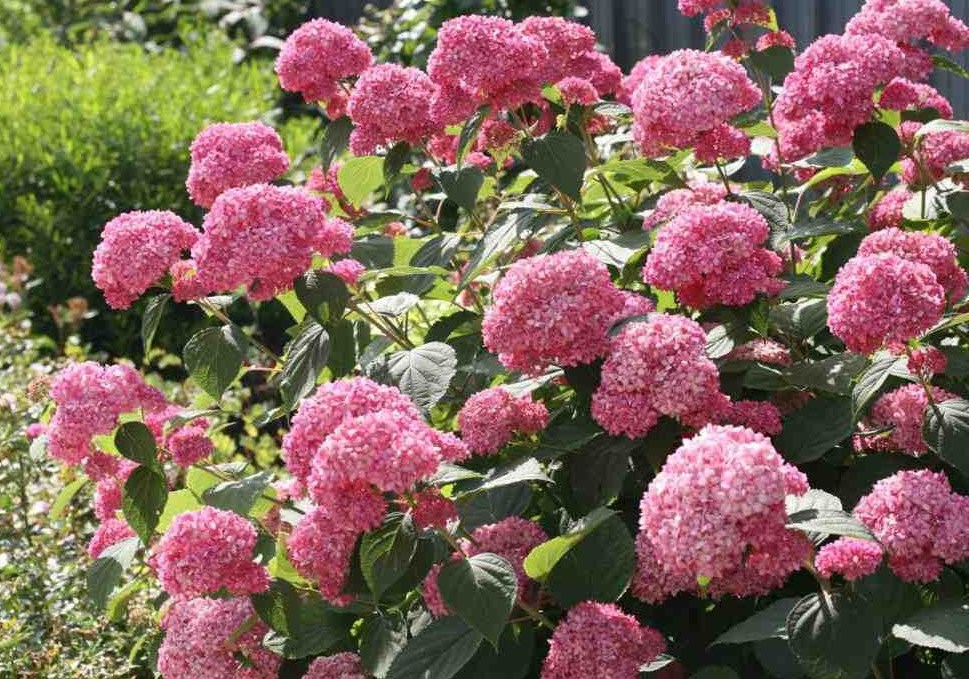 To summarize the care recommendations, we can say the following:
To summarize the care recommendations, we can say the following:
Hydrangea needs plenty of watering.
Hydrangeas are needed regular feeding mineral fertilizers.
Hydrangeas, with the exception of large-leaved and petiolate ones, require short pruning to obtain luxurious inflorescences early spring.
Large-leaved hydrangea cannot be pruned and is carefully covered for the winter.
Tree hydrangea often decorates gardens and parks, squares and alleys. The Annabelle variety is loved by gardeners for its neat compact bush, ease of cultivation and snow-white flower head.
Features of the hydrangea variety "Annabelle"
Tree hydrangea “Annabelle” is a small, neat bush no more than one and a half meters high, with a crown width of up to three meters. The bush is strewn with large, up to 20 cm long, oval leaves, rich green in color, with a pointed tip. The leaves retain their bright color until the first frost.
At the end of June, "Annabelle" blooms and stands, decorated with white flowers, until September. The flowers are small, up to 2 cm in diameter, but thanks to the dense inflorescence they look like a single white ball. "Annabelle" - decorative variety resistant to cold climatic conditions and not capricious in care; the bush will live in one place and at the same time preserve decorative look about fifty years.
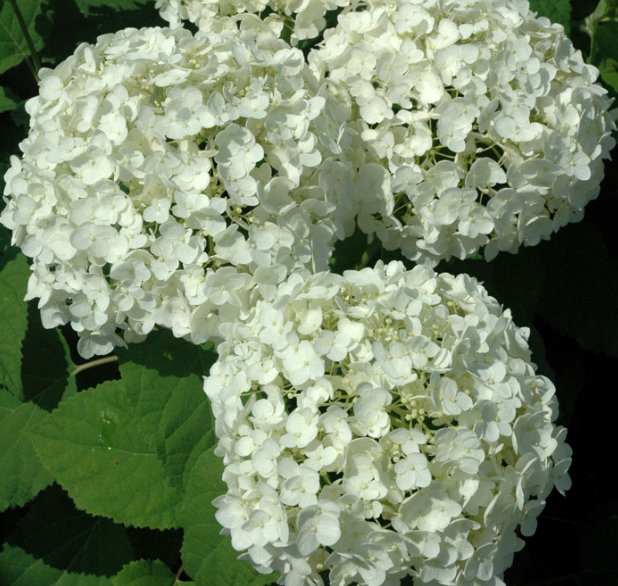 In the description of the tree hydrangea “Annabelle,” the most interesting thing is its ability to absorb dyes from the soil and take on the desired color of the flowers. If you add preparations with aluminum to the soil, the flowers of the plant will turn blue. If you want pink, you need to remove aluminum from the soil. You can do this using phosphate fertilizers or dolomite flour.
In the description of the tree hydrangea “Annabelle,” the most interesting thing is its ability to absorb dyes from the soil and take on the desired color of the flowers. If you add preparations with aluminum to the soil, the flowers of the plant will turn blue. If you want pink, you need to remove aluminum from the soil. You can do this using phosphate fertilizers or dolomite flour.
Tree hydrangea "Strong Annabelle" - one of the variations of "Annabelle" - a bush one and a half meters high. This subspecies is no different from “Annabelle” in planting and care; it also tolerates frost well and is resistant to diseases. The flowering of this subspecies is much more magnificent and abundant. When 'Strong Annabelle' blooms, there is almost no foliage visible under the balls of flowers. The bush blooms from the beginning of the summer months until the beginning of autumn.
Hydrangea arborescens 'Pink Annabelle' is different pink inflorescences. The height of the bush is slightly more than a meter, strong stems are erect and do not bend to the ground. The bush blooms in July and blooms until late autumn. The variety is winter-hardy, disease-resistant and easy to care for.
Did you know? Excavations in Alaska have uncovered hydrangea fossils; It turns out that hydrangea grew in North America 70 thousand years ago. In modern China, they also find confirmation of the existence of hydrangea in such ancient times: archaeologists have found fossilized flowers of a plant, the approximate age of which is 25-30 thousand years.

Features of planting hydrangea "Annabelle", choice of location and soil
Tree hydrangea seedlings are planted in spring and autumn, respectively in May or September. If you buy seedlings in the spring, their buds should be unopened and tightly closed.
How to choose a place to land Annabelle
For Annabelle hydrangea, choosing the right site when planting will greatly facilitate both cultivation and care. First of all, the site must have shelter from drafts. Please note that hydrangea does not like to be in the shade for a long time, but does not tolerate strong sun – the best option there will be light partial shade.
Important! Do not plant hydrangea next to trees or shrubs, they will draw all the moisture onto themselves. With a lack of water, hydrangea develops and blooms poorly.
Choosing soil for growing shrubs
Tree hydrangea "Annabelle" grows well in well-drained, acidic and nutritious soils.
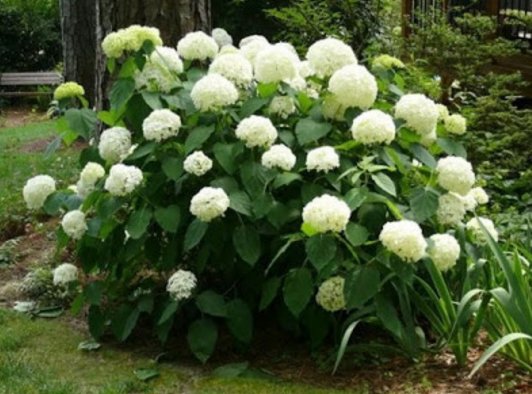 Loams that retain moisture are preferable for it. Since the plant does not like replanting, the location must immediately be chosen taking into account all the requirements of the species. landing pit for the seedling, it is prepared a week in advance to allow the soil to compact and become saturated with oxygen. The fertilizers at the bottom of the pit should be evenly dispersed along the bottom and have time to dissolve.
Loams that retain moisture are preferable for it. Since the plant does not like replanting, the location must immediately be chosen taking into account all the requirements of the species. landing pit for the seedling, it is prepared a week in advance to allow the soil to compact and become saturated with oxygen. The fertilizers at the bottom of the pit should be evenly dispersed along the bottom and have time to dissolve.
The main stages of planting hydrangea variety "Annabelle"
How to grow Annabelle hydrangea: the first condition is proper planting. Before the procedure, the seedling is soaked in a warm, slightly pink solution of potassium permanganate. The hole is made half a meter deep; if you plant several bushes, leave a distance between them of one and a half to two meters. In the case of poor soils, add a mixture of leaf soil, peat, sand and humus to the hole. equal parts, adding complex mineral fertilizers.
Important! It is not recommended to add lime, chalk or ash: these substances have an alkaline reaction, and hydrangea does not tolerate them. If the soil in your area is slightly alkaline or neutral, water the bush with sour water.
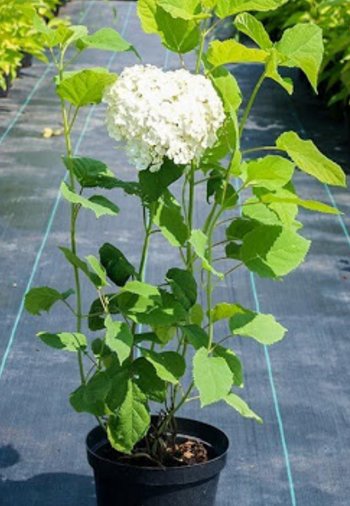 Place a mound of prepared substrate at the bottom of the hole, place the seedling and straighten the root system. Fill with soil, leaving the root collar at ground level, and tamp lightly.
Place a mound of prepared substrate at the bottom of the hole, place the seedling and straighten the root system. Fill with soil, leaving the root collar at ground level, and tamp lightly.
After planting, water the hydrangea and mulch the tree trunk.
When growing hydrangea in the Urals, after planting, it is advisable to make something like a greenhouse-type canopy to protect the fragile seedling from possible cold snap.
Rules for growing hydrangea "Annabelle" in the garden
In the first years of cultivation, it is advisable to water the soil around the seedling with a slightly pink solution of manganese to protect it from insects. It is also worth plucking off the inflorescences so that the bush spends more energy on growth. How to properly care for “Annabelle”, we will consider further.
How often to water Annabelle
Hydrangeas need abundant and regular watering; the soil should not be allowed to dry out.
On especially hot days, watering is carried out twice a week so that the roots do not dry out, and the tree trunk circle is mulched.
Features of fertilizing and soil care
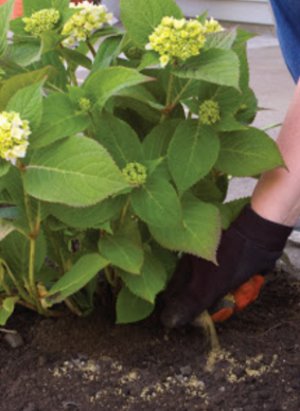 During the period of active growth and flowering, "Annabelle" needs mineral and organic fertilizers for flowering plants.
During the period of active growth and flowering, "Annabelle" needs mineral and organic fertilizers for flowering plants.
Three times a season, the plant is watered with a solution of acid manganese potassium.
During the flowering period, the dosage of fertilizing is reduced, otherwise the inflorescences will turn green.
It is imperative to loosen the soil around the bush, saturating it with oxygen, and weed it from weeds.
Tree hydrangea pruning
Formative pruning begins in the first year of the plant’s life; at the beginning of spring, a low skeleton-base is left, and shoots are cut to 12-15 cm. Subsequently, depending on the length of the grown branches, they are reduced by 2-5 cm. Sanitary pruning consists of removing weak or damaged shoots. Whatever pruning you do, it is better to do it before the sap begins to flow - in early spring or late autumn. This rule applies to all varieties of hydrangea, including "Strong Annabelle" and "Annabelle" pink when grown.
Did you know? Hydrangea is a symbol of sincere feelings and abundance in the home. 95% of the world's hydrangea cultivation belongs to Holland, where about 40 million flowers are sold at flower auctions a year.
Peculiarities of propagation of hydrangea "Annabelle"
The best way propagation of hydrangea by cuttings. In the fall, shoots of the current year that have not bloomed are cut up to 15 cm long. The cuts are kept in a root formation stimulator, then planted in a garden bed in partial shade. The cuttings are covered with a greenhouse ( plastic bottle). The greenhouse is regularly removed for some time for ventilation.
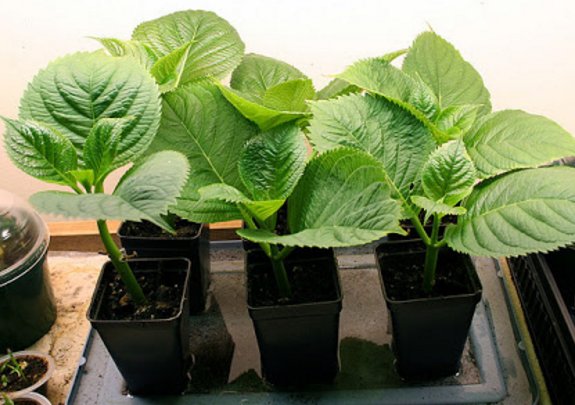 In the first year of life, seedlings are afraid low temperatures, therefore, for the winter they are covered with agrofibre; in regions with harsh winters, the cuttings are dug up, transplanted into pots and stored in the cellar. When storing this way, it is important to monitor the soil moisture in the pot. In May, the strengthened plant is freed from the greenhouse; if stored in a cellar, it is planted on the site.
In the first year of life, seedlings are afraid low temperatures, therefore, for the winter they are covered with agrofibre; in regions with harsh winters, the cuttings are dug up, transplanted into pots and stored in the cellar. When storing this way, it is important to monitor the soil moisture in the pot. In May, the strengthened plant is freed from the greenhouse; if stored in a cellar, it is planted on the site.
The second method of reproduction is by arcuate layering. In the first month of autumn, an annual shoot is chosen. They dig a groove under it and, having made a small cut on the stem of the shoot, place it in the groove with the cut down. To prevent the branch from rising, it is reinforced with wire staples. Fill the ditch, water and mulch. The next season, in the fall, the cuttings are separated from the mother bush and transplanted to a permanent place.
How to prepare a plant for winter
Hydrangea 'Annabelle' is described as frost-resistant plant, in regions with a milder climate, an adult bush does not require shelter for the winter.
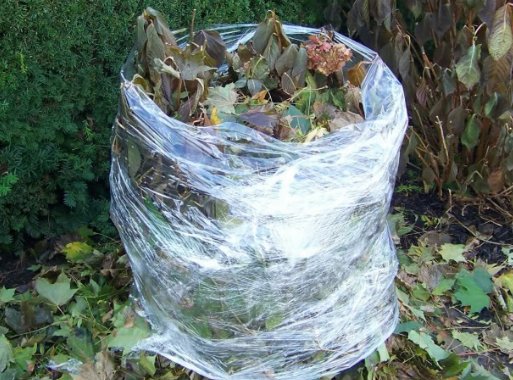 Another thing is young bushes or areas with cold winters. In any case, in preparation for winter, the plant is cleared of dry leaves and branches, the trunk circle is covered with a thick layer of sawdust, the bush is pressed as much as possible to the surface of the soil and spruce branches are laid on top. You can cover it with oilcloth and secure it. Thus, it is reliably protected and root system, and the bush itself.
Another thing is young bushes or areas with cold winters. In any case, in preparation for winter, the plant is cleared of dry leaves and branches, the trunk circle is covered with a thick layer of sawdust, the bush is pressed as much as possible to the surface of the soil and spruce branches are laid on top. You can cover it with oilcloth and secure it. Thus, it is reliably protected and root system, and the bush itself.
If several shoots have frozen over the winter, there is no need to rush to remove them; in the spring sunshine the branches will move away and bloom the next season.
Hydrangea "Annabelle" in your garden can serve decorative hedge, center flower bed or compositions with coniferous plants. These flowers go well with roses, phlox, bells and irises. Hydrangeas also look impressive next to them different varieties, colors and shapes of inflorescences.
Was this article helpful?
Not really
If you are looking for a spectacular plant for your garden, then hydrangea is a wonderful option. Variety of varieties(about 80!) allows you to choose the color and shape of the inflorescences, and the unpretentiousness of the plant will take you a little time to care for.
Hydrangea lives from 3 to 6 years, grows quickly, blooms thickly and for a long time.
Hydrangea has many types, the most popular of which are two, the first is paniculate. With it, the hydrangea does not have a main trunk, but is a bush. The second type is called tree-like; such hydrangea grows centrally and takes the shape of a small tree.
Hydrangea is planted in early spring or early autumn. This type of plant feels good in soil with high level acidity If there is alkali in the soil, the hydrangea develops leaf chlorosis.
You need to choose a place to plant hydrangea taking into account the fact that it does not tolerate wind well. Hedge or a fence will become excellent protectors from drafts. In this case, the place itself should not be in the open sun, then the hydrangea will begin to dry out, but the shady side is also not suitable, flowering will be sparse.
When planting hydrangea seeds, you need to carefully take care of the soil. It should contain peat, coarse sand, soil with leaves, humus and complex fertilizers.
Growing hydrangea from seeds is quite a difficult task, so for close supervision, you can first plant the seeds in a pot and then transplant them outside. Having planted in the spring, within a month you will see shoots.
Reproduction and planting in open ground
 Cuttings- the hole for the shoot should not be deep, but wide, since the roots of the flower are located at the very surface. In spring, seedlings should not be chosen with buds that have already blossomed.
Cuttings- the hole for the shoot should not be deep, but wide, since the roots of the flower are located at the very surface. In spring, seedlings should not be chosen with buds that have already blossomed.
Escape– in order to form shoots from an adult bush, it is necessary to press flowering, not yet woody branches to the ground. First you need to make a cut on the branch and fertilize the trench. Raise the bud itself vertically above the ground. IN next year you will receive individual cuttings.
Division– It is best to split the bush in April or September. To do this, the hydrangea is completely dug up and divided into several parts depending on the connections in the root system.
Flower care
All varieties of hydrangea are preferred high degree soil moisture. It requires regular watering of the soil within a radius of one and a half meters from the base of the bush. Experienced gardeners advise trim old hydrangea shootsearly spring, this is done to create a large volume due to the branching of the bush. If the favorable time for pruning is missed and the plant is already in the flowering phase, then it is better not to touch it, as this may weaken the hydrangea.
Regular feeding will give the bush a healthy look and accelerate the growth of shoots.
It is advisable to use it every two weeks liquid fertilizer, organic is enough to add to the soil once a month. At the end of summer, fertilizing is stopped.
Hydrangea tolerates winter well. If your region has thick snow cover and does not strong winds, then the adult bush does not need to be covered. For the first winter young plant need to shelterfrom spruce branches.
Common types and varieties
Hydrangea is represented by many varieties, which belong to several types:
The most common in the middle zone.
Lime Light. As the name suggests, the flowers of this variety initially have green, then lighten to a light lemon tint. The bush is dense, up to 240 cm in height, the crown is 180 cm in diameter. This species looks good in dry bouquets.
Vanilla Frays. The inflorescences acquire red color towards the end of summer, and at the beginning they turn ivory. The buds are large, the bush itself is not spreading, the height reaches 150 cm.
Silver Dollar. The bush of this variety develops evenly and in adult form reaches 250 cm in width and height. Silver's inflorescences are shaped like a pyramid, the color gradually turns from white to pinkish.
Phantom. Compared to other representatives of the paniculate species, this variety has large pyramidal buds. The light cream shade turns into pale pink by the end of summer.
Pinky Winky. A curious variety with double flowering. The white inflorescences turn pink by August, and then young white buds bloom from them. By late summer you get two-colored panicles.
Represented by the following popular varieties:
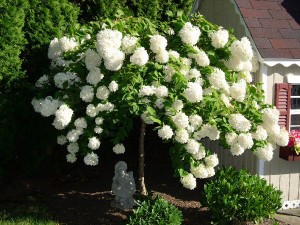 Anabelle. This is a low bush from 120 to 150 cm, growing in width to a maximum of 150 cm. It grows quickly, the inflorescences of the Anabel variety are symmetrical, neat, on average 25 cm. The color is creamy white, but experts can influence it by watering with safe dyes. With special skill, you can grow two flowers on one bush. This result requires perseverance and regular stay in the garden. This variety is extremely popular and, thanks to selection, has several variations.
Anabelle. This is a low bush from 120 to 150 cm, growing in width to a maximum of 150 cm. It grows quickly, the inflorescences of the Anabel variety are symmetrical, neat, on average 25 cm. The color is creamy white, but experts can influence it by watering with safe dyes. With special skill, you can grow two flowers on one bush. This result requires perseverance and regular stay in the garden. This variety is extremely popular and, thanks to selection, has several variations.
Pink Annabelle. As the name suggests, the color of the inflorescences of this variety is pink. The plant blooms until frost. The bush is the same size as a simple Anabel, the shoots are strong and do not spread on the ground after rain. The shape of the buds is spherical, the number of flowers is four times greater than the Anabel variety.
Strong Anabel. The round, snow-white inflorescences increase due to pruning and acquire sizes of up to 30 cm. In spring, strong pruning is necessary. The variety is frost-resistant and not afraid of diseases.
Grandiflora. She is larger than Anabel and reaches 200 cm in height and 300 cm in diameter. The flowers are white. 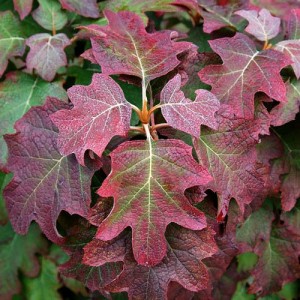
Differs from other species in its rough and rough leaves:
Snow Queen. Refers to a more thermophilic species than paniculata hydrangea. The leaves are large, dark in color, similar in shape to oak. The flowers change color from white to soft pink.
Large leaf hydrangea does not tolerate the cold season in open ground, it is taken out in a pot outside only in the summer:
Freedom. A unique feature of this variety is that the small flowers have two colors. From just pink they become white with a delicate reddish edging.
A feature of almost all types of hydrangea is late flowering, most often the period opens in July and ends with frost. Therefore, if along with early blooming flowers This plant will appear in your garden, the landscape will delight the eye throughout the warm season.

